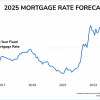
You may have applied for a loan that includes down payment assistance (DPA) only to find out the rate is 0.50% to 1% higher than standard FHA or conventional rates.
As an example, the Texas State Affordable Housing Corporation offers an FHA loan with a 5% down payment assistance loan included. As of this writing, the site’s calculator quotes a rate of 7.625%.
But according to the Optimal Blue Mortgage Market Indices, the average FHA rate is currently just 6.555%. The down payment assistance program rate is more than 1% higher than standard FHA rates.
On the surface, it doesn’t make sense. Why are rates higher for first-time homebuyers on a tight budget?
The short answer is that there are two main hurdles for homebuyers: the upfront cost and the ongoing monthly cost.
Down payment assistance programs focus on reducing the upfront cost, even if it means increasing the monthly payment.
But why must the rate be higher than standard?
State and Government DPA Program Sustainability
No government agency could afford to give away such large portions of money indefinitely.
Any fund, no matter how large, would run out of money too quickly. It would not last long enough to help a significant number of people.
For example, if a government agency gave away a 3.5% down payment on a $300,000 home, it would cost $10,500 per buyer, not including administrative costs.
With a budget of $10 million, that fund could only help about 950 buyers before it was exhausted. This would leave plenty of buyers in the state, city, or county frustrated.
To extend funds, some programs generate fees, which pour back into the program and make it available to more buyers. And the higher the interest rate on a loan, the more profit it generates.
So, it makes sense that a loan with a high rate will generate more income to pour back into the DPA fund and help create a sustainable program.
Speak to a lender to find DPA Programs in your area.
Yes, state agencies and other government-run DPA programs cost money. The initial and ongoing seed money comes from federal, state and local sources, says the National Housing Conference. Examples include:
State budgets approved by legislature
Federal money earmarked for affordable housing
Corporate and individual donors
Investors who may receive a return on loaned funds
The issuance of bonds, which pay the bond buyer interest
DPA programs are by no means money-making propositions. The goal is sustainablility. If nothing else, you can know that paying a higher interest rate is helping more first-time buyers like you get into homes.
Lender Down Payment Assistance Programs
Many lenders also offer proprietary down payment assistance loans. These come in two main types:
Programs for underserved areas
Nationwide lender DPA programs
CRA Programs For Underserved Areas
Many lenders are mandated by the Community Reinvestment Act to lend in traditionally underserved areas, typically low- and moderate-income neighborhoods.
If a lender isn't lending in a specific area, it must create programs to increase activity there. One example is Flagstar’s $50 million investment in community development programs including down payment assistance.
These mortgages likely do not require higher rates or fees since they are bank-funded. The bank's motivation is to support communities and stay in compliance with the law.
You can tell when it’s a CRA-focused program when it’s available only in certain cities or neighborhoods.
However, nationwide lender DPA programs are something completely different.
Nationwide Lender DPA Programs
If a lender’s DPA program is available nearly nationwide, that means it does not come from a state agency and is not a CRA program.
These are fully funded by higher rates and fees.
The lender charges rates about 1-2% higher than market. In addition, they charge 2 or 3 lender “points.” A point is equal to one percent of the loan amount.
It’s not uncommon to see a rate in the 8s if market rates are in the mid-6% range.
The lender funnels the large profit generated to a third-party organization, which in turn sends down payment funds to the buyer at closing.
In essence, you fund your own down payment.
Speak to a lender about DPA. Find one here.
While typically not as good a deal as government-sponsored and CRA-related down payment assistance, this DPA type can still be useful.
Many buyers are over income limits for local DPAs and are not buying in CRA areas. Yet, they don’t have a down payment. That’s when self-funded DPA loans come in handy.
In some cases, you can use seller concessions to pay the extra loan fees. In this way, the seller funds the DPA.
DPAs of this kind are not a scam. Buyers shouldn’t feel bad if they use them. However, you can get a much lower rate and fees by saving up a down payment as small as 3% for conventional loans and 3.5% for FHA.
Nevertheless, lender DPA is still worth looking into. Just make sure you explore state-funded programs and other options as well. Here are 7 places to look for DPA.
Higher Rates for DPA Programs: Often Worth It
While it would be nice to get a rock-bottom rate and your full down payment covered at the same time, that’s not how most DPA programs work.
It's usually worth accepting a higher rate if it means you can buy a home five or 10 years earlier.
Gaining the home equity and experience as a homeowner is worth far more than the lowest possible mortgage rate.




